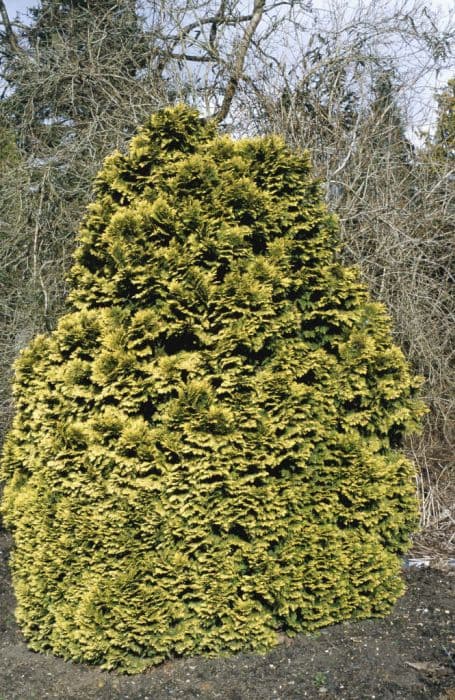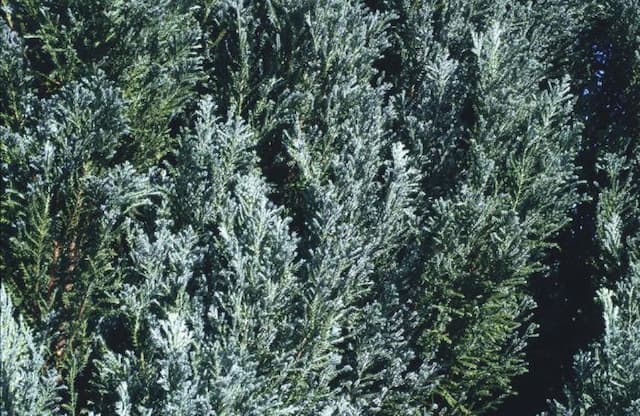Leyland cypress 'Castlewellan' × Cuprocyparis leylandii 'Castlewellan'

ABOUT
'Castlewellan' is a vigorous columnar evergreen conifer to 25m or more, with flat sprays of golden-yellow foliage, sometimes tinged bronze
About this plant
 Names
NamesFamily
Cupressaceae.
Synonyms
Castlewellan Gold, Leyland Cypress, Gold Rider.
Common names
Cupressocyparis leylandii 'Castlewellan', × Hesperotropsis leylandii 'Castlewellan', Callitropsis × leylandii 'Castlewellan', Cupressus × leylandii 'Castlewellan', Hesperocyparis × leylandii 'Castlewellan'.
 Characteristics
CharacteristicsLife cycle
Perennials
Foliage type
Evergreen
Color of leaves
Green
Height
40 feet (12 meters)
Spread
10 feet (3 meters)
Plant type
Tree
Hardiness zones
6 to 10
Native area
Hybrid - No true native area
Benefits
 General Benefits
General Benefits- Privacy Screening - The dense foliage of Leyland Cypress offers an excellent screen for privacy, blocking out unwanted views or neighboring properties.
- Windbreak - It acts as a windbreak, protecting gardens, crops, and properties from strong winds.
- Fast Growth - Leyland Cypress is known for its rapid growth rate, which means quick establishment and results for landscaping projects.
- Noise Reduction - Due to its thick foliage, it can help dampen noise from roads or neighbors, contributing to a quieter environment.
- Erosion Control - Its root system can help stabilize soil, preventing erosion on slopes or in areas prone to soil degradation.
- Aesthetic Appeal - With its attractive conical shape and evergreen foliage, it provides year-round visual interest in the landscape.
- Habitat for Wildlife - Provides shelter and nesting sites for birds and other wildlife.
- Adaptability - It can thrive in a variety of soil types and conditions, making it a versatile choice for different landscapes.
- Low Maintenance - Once established, it requires minimal care, making it ideal for those seeking a low-maintenance landscaping option.
 Medical Properties
Medical PropertiesThis plant is not used for medical purposes.
 Air-purifying Qualities
Air-purifying QualitiesThis plant is not specifically known for air purifying qualities.
 Other Uses
Other Uses- Leyland Cypress 'Castlewellan' wood shavings can be used as a natural filler in homemade stuffed toys or pillows, providing a woodsy scent and soft texture.
- The dense foliage makes it suitable for creating garden sculptures by shaping and pruning, offering a creative and living art form for landscape artists.
- Dried branches of the Leyland Cypress can be used for making rustic wreaths or other decorative items for festive occasions.
- The tree can be employed in noise reduction strategies along highways or busy roads due to its dense growth habit which can help absorb sound.
- In theater and film production, branches from the Leyland Cypress 'Castlewellan' can be used to create realistic forest scenes or as natural backdrops.
- Crafters may use the wood for creating small wooden items like picture frames, trinket boxes, or even carving projects due to its workable nature.
- Young and flexible twigs can be woven into baskets or other forms of decorative and functional wickerwork.
- In larger properties, Leyland Cypress hedges can be used to create 'rooms' or private spaces by forming living walls within gardens.
- Biomass produced from pruning or chopping down the trees can serve as a renewable energy source if properly processed and utilized.
- Thick hedges of Leyland Cypress can act as windbreaks, protecting smaller plants and reducing erosion in exposed locations.
Interesting Facts
 Feng Shui
Feng ShuiLeyland Cypress is not used in Feng Shui practice.
 Zodiac Sign Compitability
Zodiac Sign CompitabilityLeyland Cypress is not used in astrology practice.
 Plant Symbolism
Plant Symbolism- Privacy: The Leyland Cypress is often used as a natural privacy screen in landscaping due to its fast growth and dense foliage, symbolizing the desire for personal space and seclusion.
- Endurance: The tree's ability to withstand various climates and conditions represents resilience and the ability to endure challenges.
- Longevity: As an evergreen, the Leyland Cypress symbolizes long life and immortality, reflecting the enduring aspect of nature.
- Protection: Its use as a windbreak signifies the Leyland Cypress's role as a protector against natural elements and life's hardships.
 Water
WaterLeyland Cypress trees, including the 'Castlewellan' variety, should be watered regularly to establish a strong root system, especially during their first growing season. To prevent drought stress, water them deeply once a week, providing about 1 to 1.5 gallons for small trees and 2 to 3 gallons for larger ones. After establishment, reduce watering frequency to when the soil feels dry a couple of inches below the surface. During extreme drought, additional watering may be necessary to keep the trees healthy.
 Light
LightThe Leyland Cypress 'Castlewellan' thrives best in full sun conditions and should receive at least six hours of direct sunlight each day. An ideal spot would be an open area away from larger structures or trees that might cast shade, ensuring it gets plenty of light throughout the day. Partial shade is tolerated but may result in a less dense growth habit.
 Temperature
TemperatureLeyland Cypress 'Castlewellan' tolerates a wide temperature range but prefers the milder conditions. They can survive minimum temperatures down to about -20 degrees Fahrenheit but grow best when temperatures are consistently above freezing. The ideal temperature range for vigorous growth is between 35 and 85 degrees Fahrenheit, but they can tolerate occasional spikes above and drops below this range.
 Pruning
PruningPrune Leyland Cypress 'Castlewellan' to shape the plant, promote denser growth, and maintain its size. The best time to prune is late winter or early spring before new growth begins. Prune annually, but avoid cutting into the older wood because it may not regrow. Light shaping can be done throughout the year to remove any dead or unwanted branches.
 Cleaning
CleaningAs needed
 Soil
SoilLeyland Cypress 'Castlewellan' thrives in a well-draining, loamy soil mix with a pH ranging from 6.0 to 8.0. A combination of sandy loam or clay loam enriched with organic matter will support its growth. Mulching can help retain soil moisture and regulate temperature.
 Repotting
RepottingLeyland Cypress 'Castlewellan' is primarily grown outdoors and does not generally require repotting. For young trees in pots, repot every 2-3 years until they are planted in the ground.
 Humidity & Misting
Humidity & MistingLeyland Cypress 'Castlewellan' is adaptable but prefers outdoor conditions with average ambient humidity; it does not require specific humidity levels to thrive.
 Suitable locations
Suitable locationsIndoor
Not ideal indoors, Leyland Cypress 'Castlewellan' needs space, light.
Outdoor
Plant in sun, well-drained soil; space for growth.
Hardiness zone
6-10 USDA.
 Life cycle
Life cycleLeyland Cypress 'Castlewellan' begins its life as a seed, needing moist, well-drained soil to germinate. Once germinated, the seedling stage involves establishing a root system and producing its first leaves, which can take several weeks to months. During the juvenile stage, the fast-growing tree rapidly gains height and foliage, often growing several feet per year, and it can start resembling its mature shape. It then enters its mature phase, characterized by a thick and full canopy, reaching heights of 70 feet or more, and it can begin to produce cones once it reaches sexual maturity. The reproductive stage involves the development of male and female cones, usually on the same tree, with wind pollination facilitating seed production. After many years, often several decades, the tree enters its senescence phase, where growth slows down, and it may show signs of decline before eventually dying.
 Propogation
PropogationPropogation time
Spring-Early Summer
The most popular method of propagation for the Leyland Cypress 'Castlewellan' is through semi-hardwood cuttings. This process usually takes place in late summer to early fall, when the current season's growth has matured slightly but is not yet fully hardened. Cuttings should be about 6-8 inches (15-20 cm) in length, and it's essential to make a clean cut just below a node, where the concentration of growth hormones is higher. The lower needles should be stripped off, and the cut end might be dipped in a rooting hormone powder to enhance root development. Then, the prepared cuttings are placed in a well-draining potting mix, ensuring at least one node is buried where roots will form. The pot should be kept moist and in a warm area with indirect light until roots have established, which can take several weeks to a few months.









